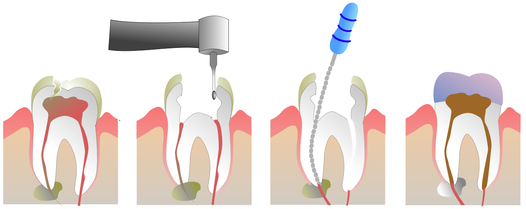Email: [email protected] | Contact: 09 827 4067
ROOT CANAL TREATMENTS
If you have been experiencing severe tooth pain, it is possible that you may require root canal treatment. In addition, if your tooth has become damaged or cracked, have tooth decay, large fillings or have recently had a trauma to the tooth, the chance of a root canal procedure increases, as these scenarios all leave your tooth open to infection.
When is a root canal required?
Root canal treatment (or endodontics) is required when an infection is deep within your tooth. For example, the blood or nerve supply may be infected due to an injury or a severe cavity. You may not experience any pain or discomfort during the early stages of an infection. However, if your tooth changes colour and darkens, that is a sign that your tooth nerve is dying. If left untreated, this kind of infection can not only be very painful but can lead to a tooth abscess or even tooth loss.
Five signs of infection:
- Serious toothache when eating or when you put pressure on the tooth. Does it hurt when you bite down hard?
- Excessively sensitive teeth. Does the sensitive pain linger after the initial contact with hot or cold foods or drinks?
- Darkening of your tooth. Has your tooth changed colour? This may be a sign of the nerve dying.
- A small bump on the gum, close to the painful tooth.
- Tender or swollen gums around the tooth.
Why is it called a root canal?
Above the gumline, the visible part of your tooth is called the ‘crown’. Below the gum, fixing the tooth to the jaw is the ‘root’ of your tooth. The root canal system is a network that fills a central hollow area inside the tooth and down to the roots. Root canals are filled with loose connective tissue called ‘dental pulp’. They are responsible for nourishing and hydrating the tooth and reacting to hot and cold.
When an infection takes hold, this pulp becomes inflamed, which is why it may be painful to eat or drink. Eventually, a bacterial infection will cause the pulp to die. If you are experiencing a toothache, it is important to see your dentist, as the infection will not go away of its own accord, and antibiotics cannot be used to treat a root canal infection.
If left untreated, a deep infection can spread through the whole root canal system of your tooth. In this case, the pain may subside, as the infection will have removed all of the pulp.
When an infection takes hold, this pulp becomes inflamed, which is why it may be painful to eat or drink. Eventually, a bacterial infection will cause the pulp to die. If you are experiencing a toothache, it is important to see your dentist, as the infection will not go away of its own accord, and antibiotics cannot be used to treat a root canal infection.
If left untreated, a deep infection can spread through the whole root canal system of your tooth. In this case, the pain may subside, as the infection will have removed all of the pulp.
What does treatment involve?
Root canal treatment (clinically known as Endodontic treatment) removes all of the infection from the tooth before sealing the tooth to protect the damaged nerve and restore you back to good oral health.
|
When you first come in, we will take an x-ray to assess the status of the infection. Then a local anaesthetic is administered to the area. Next, a rubber material called a ‘rubber dam is placed around the tooth to keep it dry and accessible throughout the procedure. Once you are fully anaesthetised, your dentist will use specially designed tools to remove the infected tissue. Once it is clear, a rubber compound fills the tooth where the root canal tissue previously was. This is usually finished with a temporary filling. This is the completed stage of your first visit. Following this, we create a custom made crown to fit your tooth, which is fitted at your second visit.
|


